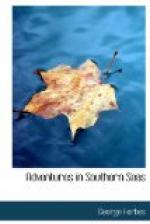Not wishing to engage these savages, Hartog stood out to sea, but so fearless were they that when they saw us they came in pursuit of us. Over twenty canoes crowded with natives put off from the shore, but we greeted them with shots from our brass cannon, which sent them back quicker than they came, many being observed to fall after each discharge of grapeshot and canister amongst them.
We left this country, which Hartog named Staten Land, in honour of the States of Holland, with an unfavourable impression of its inhabitants, who appeared to be bloodthirsty savages, prone to hostility without provocation.
CHAPTER XLIX
THE CANNIBAL ISLANDS
After leaving Staten Land we sailed west to between the fifteenth and twenty-first parallels of south latitude, when we fell in with a number of islands, some of considerable extent, while others were mere islets of sand and rock, uninhabited except by sea-fowl and turtle. A great barrier reef surrounds the group to the eastward, leaving the southern quarter open. This barrier is broken by numerous passages, between which navigation is possible, but dangerous, except in fine weather. In addition to the great barrier, every island has an encircling reef of its own. The general appearance of these islands is bold and striking. They are perhaps the mountain tops of some sunken continent. The island upon which we landed was one of the largest of the group, with a background of wooded hills, and a fringe of palm trees to the beach, beyond which a native village stood among green foliage.
We found the inhabitants of this island not nearly so friendly as other savages we had met with. The men were larger, and bore a ferocious aspect. The chief wore a necklace of whales’ teeth, his hair frizzled into a mop, which stood out from his head, coloured to a reddish-brown. His skin was a light brown, with no tattoo marks upon it, but shiny, as if rubbed with oil. He carried a club and spear of elaborate workmanship, and wore a cloth petticoat made from the bark of a tree, and painted with some skill in its design. His followers were similarly, but not so strikingly, clad, the women wearing feathers in their hair, and a peculiar leaf from a tree, which looked like white satin. Altogether this race appeared to be possessed of a far higher state of civilization than the people in Terra Australis. They were, however, openly addicted to cannibalism, and made no secret of this abominable practice.
These natives did not display any hostility at our landing, nor did they express any surprise at the presents we made them of beads and bright cloth, although they accepted what we gave them with avidity. We stayed at this island for nearly two months, during which time we learnt something of the customs of the people, and I was able, after a while, to understand some of their language. It seemed that these savages were continually at war with one another, and the boom of the great wooden war drums was always sounding somewhere in the group. It was from prisoners taken in battle that men were provided for cannibal feasts, hence there was never lacking a cause for quarrel. The prisoners were kept in a compound, where they were fattened for the pot and killed when wanted.




